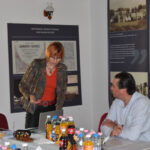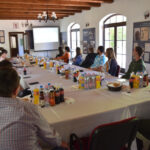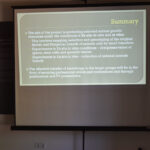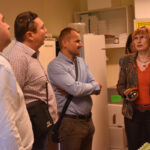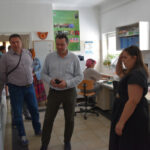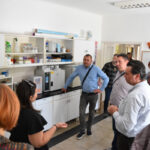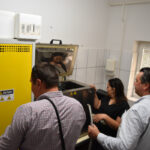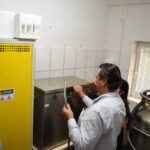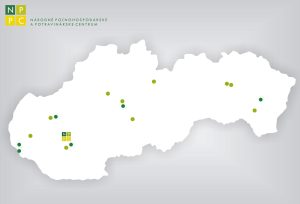
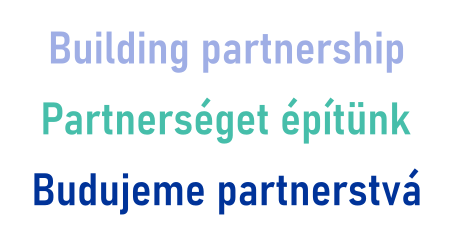

Kick off meeting - Gödöllö
Slovak – Hungarian cooperation to protect biodiversity
The Slovak National Agricultural and Food Centre (NPPC) in cooperation with the National Centre for Biodiversity and Gene Conservation (NBGK) has been awarded a grant under the Interreg VI-A Slovakia-Hungary Cooperation Program for the implementation of its project „Support for cross-border biodiversity conservation in ex situ conditions“ (HUSK/2302/1.2/018, #Biodiverzity).
Its total budget is 998 683,56 EUR, of which 798946,84 EUR is Community funding for the period from 1 May 2024 to 31 October 2026.
In the Danube region, due to similar environmental factors, the established indigenous species share common characteristics. Both countries are facing the loss of native varieties and a significant decline in their populations as intensive farming systems become more widespread. Without conscious genetic conservation programs, these varieties could disappear permanently. Therefore, it is a priority for both nations to preserve and integrate the genetic material of these varieties into production.
This call for proposals aims to establish the foundations for long-term cooperation between the two countries. By pooling expertise from different fields, sharing knowledge, best practices and innovative solutions, we can jointly achieve our objectives. The project will be implemented collaboratively, led by the Slovak partner. Both countries will contribute resources – financial, infrastructural, and human – to ensure the successful implementation of the tasks.
Introduction of the project
The goal of the project is to foster cross-border cooperation and support in protecting biodiversity, with a focus on preserving selected animal genetic resources under ex situ in vivo and in vitro conditions. This includes the mapping, selection and genotyping of original Slovak and Hungarian animal breeds, which are raised only by small-scale breeders. Due to this, the number of individuals is very low and some breeds are at risk of extinction.
Ex situ in vitro experiments will focus on sampling for the following purposes:
- DNA isolation and determining the origin of individuals,
- Collection of ejaculates and blood for microbiological, morphological and andrological examinations,
- Isolation of stem cells from poultry and rabbits,
- Cryopreservation of biological material (sperm, stem cells, bone marrow) from national animal breeds, including the brown hare, for preservation in gene banks.
Ex situ in vivo efforts will involve collecting animals from each breed, including 13 rabbit breeds, 1 brown hare breed, 2 poultry breeds and 4 sheep breeds with at least two individuals from each breed.
The project will result in cryopreserved samples stored in gene banks on both the Slovak and Hungarian sides, mutual exchange of reserve samples and a collection of national breed animals. The effective transfer of knowledge to target groups will be ensured through professional events, conferences and publications raised throughout the project.
Objectives of the NBGK
The Hungarian Giant Rabbit is a critically endangered species. To maintain its genetic diversity, it is essential to increase the number of individuals in the nucleus population at the Institute by introducing new breeding stock based on genetic testing of external breeders. There are limited data available on the breed’s spermatological parameters and its semen’s tolerance to freezing. In addition to in vivo gene conservation, developing an in vitro method for deep freezing of semen is crucial.
Among our native poultry breeds, two are critically endangered, ten are under protected status and two are under conservation status. This further justifies the need to develop in vitro gene conservation methods for these breeds. While various semen storage protocols exist, our previous studies have shown that the efficiency of semen preservation in our indigenous poultry species often falls below international standards. Therefore, further research is required to identify the causes and improve current preservation methods.
In poultry, female gametes are heterogametic, meaning that the W chromosome and mitochondria are located in the oocyte, which cannot be preserved solely through sperm freezing. Due to the biophysical characteristics of eggs, they are not cryopreservable; however, embryonic stem cells or day-old gonadal tissue may be suitable for long-term preservation of the female genome. Among the different types of stem cells, primordial germ cells (PGCs) are precursors to sperm or oocytes, can be maintained in cell culture and are cryopreservable, making them ideal for genetic preservation.
The aim of the project is to establish stable male and female cell lines from the Slovak indigenous Oravka breed, which, after in vivo and in vitro testing, can be stored in the gene bank. Deep freezing of gonadal tissues has already been implemented for several breeds, and the goal is to expand the gene bank samples at our institute while transferring and introducing this method to the Slovak gene bank.
Both PGCs and gonadal tissue are capable of recovering 100% of the poultry genotype, preserved in the F1 generation through grafting and artificial insemination post-maturation. The results of this project will contribute to the conservation of genetic diversity in indigenous livestock breeds in both countries.
Objectives of the NPPC
The availability of animal genetic resources influences both current and future quality of life and plays a crucial role in food security. The ratification of the Convention on Biological Diversity commits the Slovak Republic to the conservation of biodiversity, the sustainable use of its components (including animal genetic resources) and the fair and equitable sharing of benefits arising from their utilization. Additionally, the protection of animal genetic resources in agriculture aligns with the European Action Plan on Biodiversity, the UN FAO Global Strategy for the Management of Animal Genetic Resources, Regulation (EC) No 870/2004 establishing a Community programme on the conservation, characterization, collection and utilization of genetic resources and Regulation (EC) No 194/1998 concerning the breeding and stockfarming of animals, as well as the conservation of genetic resources.
It is vital to conserve and maintain animal genetic resources as a safeguard against threats, such as climate change, disease, social changes, genetic problems, selection errors and unexpected catastrophic events that could significantly impact biodiversity. Utilizing sperm, stem cells, bone marrow cells and oocytes from various sources offers a promising option for conserving endangered animal breeds. This process is preceded by ex situ collection and cell cultivation under in vitro conditions, testing for origin and quality and then cryopreserving the samples.
The submitted project will focus on the mapping, selection and genotyping of Slovak indigenous breeds, assessing semen quality, collecting and characterizing stem cells and evaluating the bacteriological profile of each sample. Once suitable individuals are identified, the collected samples will be stored in gene banks. Additionally, an „ex situ in vivo“ collection of wild representatives of rabbits, poultry, sheep and hares will be established at the NPPC.
Cooperation with Hungary will focus on sharing animals, samples and methods to enhance gene conservation efficiency. The methodologies and instrumentation of the partner institutions complement each other, facilitating a more thorough evaluation of samples. The animal gene bank in the Slovak Republic will also store samples of Hungarian breeds and vice versa, ensuring that genetic material is available in both countries in the event of unforeseen circumstances.
The websites of the program and the project: www.skhu.eu, www.nbgk.hu, www.nppc.sk

